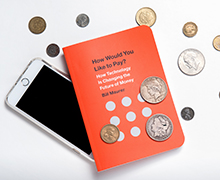Pay dirt

Pay dirt
- January 22, 2016
- Bill Maurer, dean of social sciences, shares a trove of fun facts about money
From Barbie cash registers to bitcoin, Bill Maurer is a gold mine of stories about
money.
Sitting in a sunlit office decorated with Mr. Monopoly artwork and a Plexiglas cube
full of shredded greenbacks, the University of California, Irvine anthropologist recently
discussed various financial facts, many from his new book, How Would You Like to Pay?, a pocket-size guide to money’s past, present and future.
Maurer, who also serves as dean of UCI’s School of Social Sciences, says technology
is reshaping what’s in people’s wallets and, in turn, everyday life. Here are 10 things
you might not know about money.
- In the early 1860s, about 8,000 private forms of currency circulated in the U.S., typically issued by banks, railroads and retailers. It was a financial Wild West, Maurer says. The bank notes were largely unregulated and sometimes not backed by precious metals or other reserves. It took the Civil War and the National Banking Act of 1863 to begin bringing order to the system.
- The $2 bill is the only paper note in America with an action scene on the back – the Founding Fathers presenting a draft of the Declaration of Independence to the Continental Congress. Last August, when Maurer and other experts were invited to give input on the new $10 bill, they also proposed an action scene for the reverse of the $5 bill: Keep the Lincoln Memorial, they advised, but add Martin Luther King Jr. giving his “I Have a Dream” speech to a huge crowd. The idea was nixed.
- In the book The Wonderful Wizard of Oz, Dorothy’s slippers are made of silver, not rubies, prompting some experts to view the story as an allegory about 19th-century U.S. economic policies. In this scenario, the yellow brick road represents the gold standard, and Dorothy’s slippers symbolize populist demands for an accompanying silver standard to increase the nation’s money supply. The Tin Woodman is interpreted as dehumanized industrial workers, the Cowardly Lion as populist presidential candidate William Jennings Bryan and the Scarecrow as farmers. Even the word “Oz,” it’s noted, is an abbreviation of “ounce,” the standard measure for gold. These and other alleged metaphors earned L. Frank Baum’s book a spot in the British Museum’s renowned money exhibit.
- One of the quirkiest items in the British Museum’s money exhibit (and also part of a monetary artifacts collection at UCI) is a Barbie cash register that features a slot for swiping toy credit cards. Another oddity at the museum, donated by UCI’s Institute for Money, Technology & Financial Inclusion, is an old-fashioned pair of ladies underwear with a secret pocket for storing cash.
- Over the centuries, people have used all sorts of items as money, including bullets, booze, cigarettes, shells, bear teeth, cocoa beans and elephant tail hairs.
- It’s legal in America to print your own currency – as long as it’s not in coin form and doesn’t resemble real paper bills. Any income earned in such an alternate currency must be reported on federal tax forms as barter.
- The earliest known antifraud technology was a clay envelope. Before money was invented, people tracked exchanges on cuneiform tablets. To prevent forgery on the tablets, they were sealed in clay envelopes and kept in religious temples. If a dispute arose about a transaction, the envelope could be broken open.
- Nearly a third of Starbucks transactions involve its cellphone app or customer loyalty program. Much of that business is from urban centers on the East and West coasts.
- In certain Asian cultures, paper representations of cash, cigarettes, eyeglasses, razors and other items are offered to dead ancestors. But some ghosts only accept facsimiles of U.S. dollars.
- UCI’s stash of money-related artifacts includes beads used for slave trading in Africa, a Mall Madness board game, a bottle of Money Rain spiritual perfume, a $50 trillion bill from Zimbabwe, a “Jesus saves” coin pouch and a photo of the dove that became an antifraud hologram on Visa credit cards.
-Roy Rivenburg, UCI Communications
-photo by Steve Zylius, UCI Communications
Share on:
Related News Items
- On the move: Orange County United Way welcomes new chair for its United for Financial Security Leadership Council
- Reflecting on the assets and needs of Orange County's Asian American & Native Hawaiian and Pacific Islander communities
- A cap on credit card fees would hurt department stores most
- Maurer named chair of Orange County United Way United for Financial Security Leadership Council
- As money moves digital, Denver Mint still coins a pretty penny




connect with us